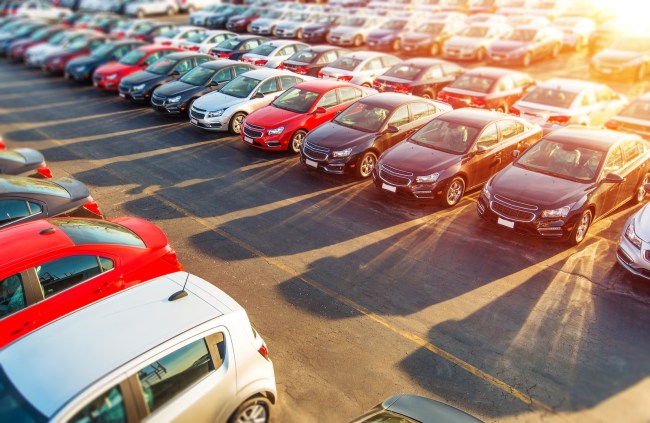
iStockphoto
So you’re buying a new car, but you don’t know anything about cars.
You’ve heard the horror stories of car salesmen and want to avoid getting hoodwinked.
Sounds like you need to learn the basics of what different kinds of cars there are, that way you don’t end up paying extra for the blinker fluid extended warranty.
A car at its core is a fairly basic thing. There are four wheels, a motor, a body, some doors and a couple other bits that all work together to get you where you’re going. There are quite a few differences between types. It’s kind of like dogs.
A dog is a dog, but a German Shepherd is different from a Chihuahua.
So too are cars different while also being the same.
WHAT ARE THE DIFFERENT TYPES OF CAR BODY STYLES?
What probably constitutes the most classic type of car is the sedan.
Picture in your head a vehicle like a Ford Taurus.
A sedan has four doors and is low slung, keeping you closer to the ground while the trunk opens on a hinge below the rear window.
Although the sedan seems to be a dying breed these days. Ford recently announced the elimination of their sedans.
The death of the sedan can be explained by the increase in popularity of the SUV.
Hell, even Lamborghini makes an SUV now.
WHAT IS AN SUV?

iStockphoto
An SUV, like a Toyota Land Cruiser, stands for Sport Utility Vehicle.
In theory, it’s a raised platform capable of clearing off-road obstacles and scaling steep hills.
In practice, the vehicle typically is used to take the kids to soccer practice.
This type of vehicle will typically come with either 4WD or AWD, though sometimes the more basic models will only drive two of the wheels.
4WD stands for Four Wheel Drive. AWD stands for All Wheel Drive. The difference between these two is AWD cannot be turned off, while a vehicle with 4WD allows you to switch between driving all four of the wheels and just two of them.
The advantage to that being centered mainly around gas mileage. Driving more wheels requires more fuel and isn’t really necessary on clear asphalt roads, where SUVs spend 99.99% of their lives.
Though driving all four wheels is useful in inclement weather, especially snow.
WELL, THEN WHAT IS AN SAV?
Then you’ve got your SAV, standing for Sport Activity Vehicle, an example being a BMW X3.
This is more the type of raised car that might not have either 4WD or AWD. Calling it an “activity” vehicle rather than “utility” seems to be the manufacturer’s way of copping to the fact that it’s not really an off-roader. It just looks like it could be one.
Personally, I appreciate the honesty.
SAV’s are similar to crossovers, which are the bastard children of an SUV and a sedan. Think along the lines of Walter White’s Pontiac Aztek. Some people will tell you crossovers blend the best of both worlds.
Why Most New Car Features Are Creating A World Of Awful Drivers
Others might tell you they suck at everything.
As far as vehicles with a higher center of gravity go, we’ve still got the pickup truck left. See the Dodge Ram.
A pickup truck will have an open bed in the back for storing things. They come in either two-door or four-door configurations. The four-door setup will probably be referred to as an extended cab, or crew cab.
Pickup trucks also tend to have a large towing capacity, that is, they’re capable of dragging heavy things behind them, like a boat.
WHAT IS THE DIFFERENCE BETWEEN A HARD AND SOFT TOP CONVERTIBLE?
Back closer to the ground, there are still many more types to go.
Obviously, you have your convertibles, with their retractable roofs, like the Mazda Miata.
In most modern cars the roof will be electronically powered, although you can still find the occasional new car that requires the manual removal of said roof.
Convertibles can be a little tricky with names, as every company tends to have a different word for them.
Sometimes they’re just a convertible, but other times they’re a spyder, a cabriolet, a roadster or a drop head. Yes, that’s spyder with a “Y.”
Sometimes it’s just regular “spider” though.
A convertible can be either a soft or hard top. A hard top will appear indistinguishable to a non-convertible while the roof is up, whereas a soft top will have a cloth material, probably a different color from the body of the car, announcing to the world that your car likes to party with its top off.
Soft tops can sometimes be called rag tops due to the material the roof is made of.
There aren’t too many of these, but some companies make what’s called a targa. Take a look at the Porsche 911 Targa if you want to see one.
A targa is something of a mix between a convertible and a giant sunroof.
The back glass of the car is static, but the entire top section of the roof is removable.
WHAT IS A COUPE?
Moving onto the coupe, demonstrated by an Audi A5.
Coupe can be pronounced with or without the “E” at the end, depending upon how snobbish you’re feeling at the moment.
Coupes are two-door cars that tend to be of the more sporting variety and have the sloped roof to prove it. Sometimes you can also get a gran coupe, as in the Mercedes-Benz CLS, which is like a coupe except it has four doors.
It’s not a sedan, though. It’s just kind of like a sedan, but still not one.
Clear? Good. Moving on.
WHAT IS A HATCHBACK?
Hatchbacks like the Volkswagen Golf tend not to be very popular in the U.S. although among car people they’re well respected for their do-it-all abilities.
You see a hatchback is what can also be referred to as a five-door car, or a three-door. The trunk is its own door, and they can come with either two or four doors on the sides.
Hatchbacks have more of a bubble shape, which I believe is why Americans don’t much like them. However, that bubble is practical, as it maximizes trunk space compared to a regular sedan.
Hatchbacks also tend to exist at the more economical strata of cars, meaning they’re both practical and affordable.
WHAT’S THE DIFFERENCE BETWEEN A HATCHBACK AND WAGON?
Very close to hatchbacks are wagons like the Subaru Outback. In essence, they’re really the same thing.
Sometimes they can be called sportback, avant or shooting brake because wagon just doesn’t sound good.
A wagon’s roofline may continue on further past the rear doors than a hatchback. They’ll tend to have a stretched out look compared to the bubble of a hatchback and wagons can exist in the higher end of the market, but otherwise, they’re basically the same thing.
Now that we’ve got all that covered and I’m sure you’re much less confused than you were before this started, it’s time to go walk into that dealership and not look like a total idiot.
Wait a minute. Oh no! I seem to have forgotten the minivan, but I’m all out of space.
Oh well.
Jordan Ulman has been driving cars since before he got his license (sorry Mom and Dad). He currently works for a high-end dealership and aspires to one day own his own exotic that never works correctly.
***

iStockphoto
Is It Better To Buy Or Lease A Car?
Did you get a huge tax refund this year? If so, you may be looking to put that chunk of change towards a new car purchase; but should you lease or buy?
The generally agreed upon financial wisdom is that purchasing is better than leasing for one obvious and major reason: once you’ve finally paid it all off, you own an asset.
I won’t argue with this.
It’s sound financial advice.
There’s a good reason that around 66% of new car sales are purchases rather than leases, according to Experian data.
For what it’s worth, about 96% of used car sales are purchased. Leasing a pre-owned car rarely makes sense.
It’s not that simple though. Here are a few reasons why:
- Purchasing new is a more expensive endeavor. It requires a larger down payment, larger monthly payments, and a longer contractual commitment.
- New loans average 68 months versus new leases only going for 36 months.
- New loan monthly payments are $530 a month on average against leases at $430 per month.
Of course, despite financing being close to twice as long of a commitment, you can always sell a car while still making payments. It won’t always make sense to do so, but you can if you have to.
If you decide you need to get out of a lease, your options are much more limited.
For the sake of comparison, the average monthly payment on a used car is $381 per month, making it the cheapest option, at least in terms of monthly payments.
In the interest of full disclosure, I drive an older BMW, an E46. As someone who sees cars as more than just a tool to get from A to B, I wouldn’t have it any other way. I could’ve leased some cheap Korean FWD economy shitbox that would’ve worked out to less than the purchase price plus running costs of my car.
The problem is that shitbox wouldn’t have brought me any joy. So it’s money well spent in my book.
The real peril you face in buying something used is the unknown repair costs that will be added on top of the monthly payments or cash purchase price.
When possible your best bet will always be to go for something certified that comes with a warranty, but of course that comes at a premium.
Still, it’s easier to plan around a static monthly payment than it is to deal with an unexpected repair bill that may cost you thousands of dollars you don’t have at your disposal.
Even if you do buy certified pre-owned with a warranty, there are still no guarantees. Warranty companies are like insurance companies. Their business model is to deny as many claims as possible.
If something on your car breaks and the mechanic finds evidence of prior work that’s simply near the area of the broken part, your warranty claim will be denied, leaving you shafted by your broken driveshaft.
In these cases, you may find yourself stuck with an unexpected diagnostic fee, even if you choose not to go ahead with the repair at dealership service center prices.
It is of the utmost importance then, if you’re buying a used car, to have it thoroughly inspected before purchase. Not only for safety issues but for any signs of previous work done.
A quality car repair shouldn’t leave signs. If there is evidence that the car’s been worked on, you should view that as a major red flag.
Which brings us to leasing something new.
A leased car will be returned to the financial institution that owns it either still under warranty or around the time the warranty runs out.
If you purchase and intend on keeping the car for a while, the warranty will obviously expire. Extended warranties are available and you would be wise to foot that bill.
Of course, leasing has some big limitations.
You don’t actually own a leased car.
When you return it, the owner of the title expects their car to be in good condition so that they might resell it. If it isn’t, you’re going to get charged for balding tires, body damage, and required maintenance.
These bills can often extend into the thousands if you’ve been careless, and if you go over the allotted mileage on your contract there will be additional charges.
Word to the wise: if you’ve leased a car and gone over mileage, call the financier of your lease before returning it.
They’ll let you buy those miles at a discounted rate. You should always follow the guidelines laid out by the leasing company and get a pre-inspection done prior to turning the car in. This way, you’ll know exactly what you’re going to be charged for.
In some instances, you’ll be able to rectify the identified problems for less.
For example, buying used tires which have just enough thread to pass inspection should cost you about one-third of what you’d otherwise be charged for new ones.

iStockphoto / SeventyFour
Leasing has its advantages as well.
You can afford more car. It comes down to the residual value.
If you lease a car with a 60% residual, your monthly payments will only be for 40% of the value of the car, plus interest. If you purchase, you’re paying for 100% of the selling price, plus interest.
Often times, for a similar monthly outlay, you can buy American or lease German. If you’re like me, this is a very tempting argument.
Ultimately it comes down to your individual situation and what you’re trying to get out of your car. If you can afford it, by all means, purchase something new.
It’s a solid financial decision with a few unexpected costs that offers flexibility if you decide to change things up. Purchase in cash if you can, too, so you don’t pay interest.
That goes for new or used.
If you’ve run the numbers and feel that a new car purchase just isn’t in the cards for you, even with financing, don’t rule out leasing.
It’s a known quantity when compared to buying used and isn’t the terrible value some might make it seem. Or, take a chance and get that used sports car you had a poster of as a kid. Us car nuts do love to live dangerously.
Ultimately it comes down to your personal situation and what you value in your car.
Every option has its pros and cons.
You won’t really know if you’ve made a good or bad decision until a couple of years after the fact.